Despite changes to management arrangements in many jurisdictions, the volume of Australian fisheries production over the past decade has remained relatively stable, particularly for key species such as rock lobster and abalone. In 2006-07, the total volume of Australian fisheries production was 240 000 tonne, approximately 3 per cent (7900 tonne) higher than in 1997-98.

There have, however, been changes to the species composition of Australian fisheries production over this period. Of particular note is the strong growth that has occurred in the production of Australian sardines (figure a). Predominantly caught in South Australian waters and used as feed in southern bluefin tuna aquaculture, production in the South Australian sardine fishery rose by more than 1000 per cent between 1999-2000 and 2004-05, from 3.8 kilotonne to 48.9 kilotonne. In 2006-07, Australian sardines accounted for 14 per cent of total fisheries production. Farmed salmonids, comprising salmon and trout species, have also emerged as a key species group in recent years, accounting for 11 per cent of total fisheries production in 2006-07.
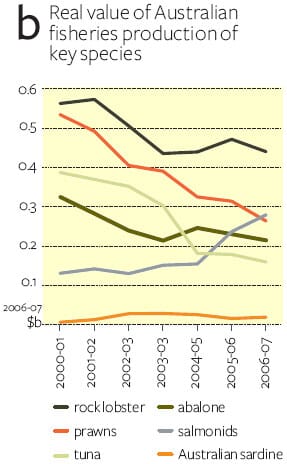
As a very low-value species, the growth in sardine production has had a negligible impact on the gross value of fisheries production (figure b). In contrast, the increase in production of farmed salmonids, combined with higher unit prices, has resulted in a $158 million increase (in real terms) in the value of this species group since 1999-2000. In 2006-07, farmed salmonids were valued at $281 million, surpassing tuna as Australia’s most valuable finfish species group.
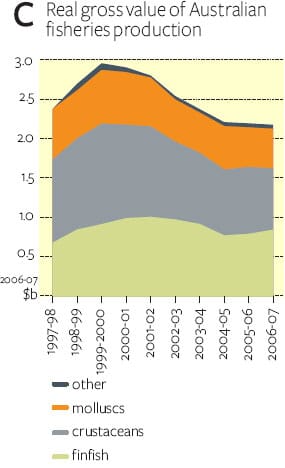
However, the increase in the production value of salmonids has not been sufficient to offset a decline in the gross value of Australian fisheries production. After reaching a peak of $2.96 billion (in real terms) in 1999- 2000, the gross value of Australian fisheries production fell by 26 per cent, dropping to a 10 year low of $2.18 billion in 2006-07 (figure c).
Driving this decline were reductions in the value of other key species, particularly rock lobster, prawns, abalone and tuna. The combined value of these four species, which typically account for at least half of Australia’s gross value of fisheries production, has fallen by 39 per cent ($0.7 billion) since 1999-2000 (figure b). This is largely the result of falling unit prices (figure d). Since the production of these species is export-oriented, prices are strongly influenced by exchange rate movements. The strength of the Australian dollar against the currencies of major trading partners, particularly the US dollar and the Japanese yen, has reduced the competitiveness of Australian fisheries exports in recent years (box 1).
box 1 Exchange rates and unit pricesBecause Australia is a small producer and exporter of fisheries products, prices received by Australian producers are generally set on world markets in foreign currencies. Other things being equal, a depreciating Australian dollar results in producers receiving a higher export price in Australian dollar terms, while an appreciating Australian dollar results in a lower export price. |
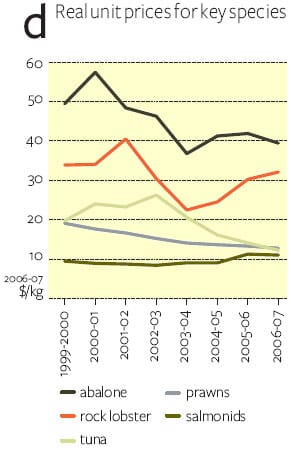
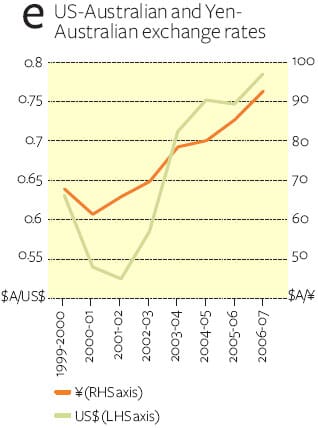
In 2006-07, rock lobster remained Australia’s highest value individual catch, valued at $441 million, followed by salmonids ($281 million), prawns ($265 million), abalone ($216 million) and tuna ($161 million) (figure f ). Australian sardines accounted for the highest individual catch by volume (14 per cent), followed by salmonids (11 per cent), prawns (9 per cent) and rock lobster (6 per cent).
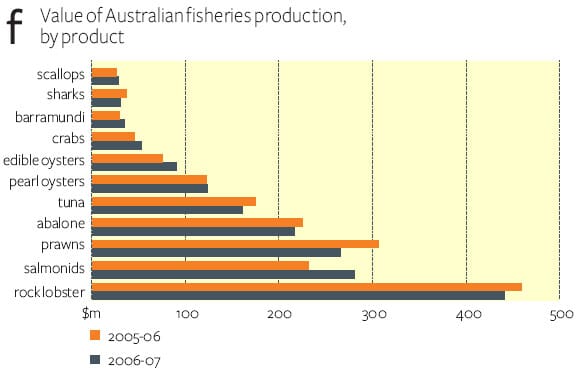
Further Reading
| - | You can view the full report by clicking here. |
June 2008

